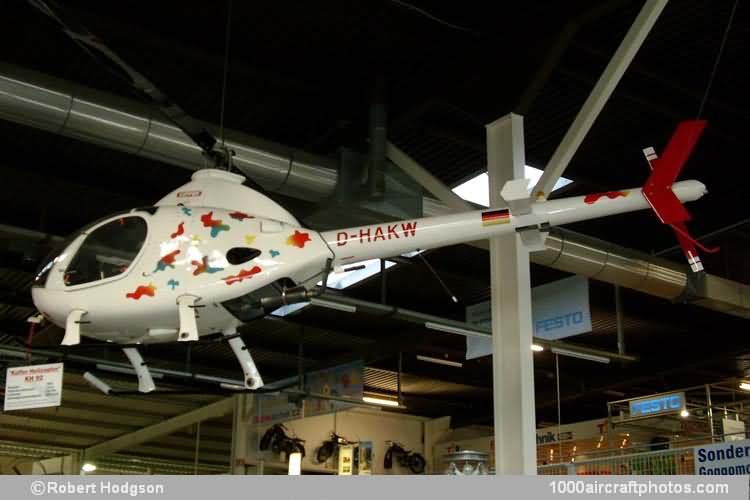10/31/2010. Remarks by Johan Visschedijk: "With design concepts evolving again in the late 1980s, RotorWay International of Phoenix, Arizona, created the Elete, a larger, attractive two-seat helicopter which showed a lot of promise, yet presented once more the numerous difficulties associated with a new model. After selling three Elete helicopters, the company finally succumbed to financial challenges and was soon purchased by a former customer, John Netherwood, a businessman from England.
The new company recognized the design hurdles of the Elete and promptly set out to address making the proven Exec model a better aircraft to sell. The Exec was reviewed from top to bottom, any and all suggestions from the experienced staff were considered, evaluated and many implemented. Extensive redesigning was done and when all was complete, 23 items were changed or improved including the aerodynamics, drive train, stability and power.
The engine was once more a primary area of improvement, a task made even easier by the fact that RotorWay had been engineering and manufacturing their own engine for years by this time. The 152 hp RotorWay International RI engine with dual electronic ignition was specifically designed for rotorcraft flight and possessed an incredibly light weight to horsepower ratio. Extended life limits were added to the chains, belts, rotor system and asymmetrical blades.
Improvements were made in every aspect of the aircraft including the method of packing and organizing the kit, the manuals, and the customer service program to assist the builder with technical information. Many critical systems were then assembled by RotorWay itself, almost all of the fabrication completed for the builder. All of the welding was now done at the factory as well. The rotor blades required little more than finishing touches. The tail boom had been formed and riveted and was ready for inspection covers to be fitted and mounted on the airframe. The wiring harness was assembled and tested, coming ready for installation.
The Exec 90 was the only piston-powered helicopter at the time to utilize asymmetrical airfoil section all-metal rotor blades and an elastomeric bearing rotor hub system, for improved autorotation characteristics and safety. The Exec 90 also utilized a unique drive system, eliminating an expensive transmission, metal chip detectors and possible in-flight failures. With all of this in place, the expected build time with the standard kit was about 500 hours.
A quick build kit was soon offered, cutting that time nearly in half. Eventually, the quick build kit became the only way in which to purchase the helicopter. The Exec 90 is the most popular kit helicopter in the world, with more than 4200 examples sold, of which 750 were of the 162F model. Presently the type is marketed as the A600 Talon and is being developed into the Eagle 300T.
Werner Küffer of Neckarsulm, Germany, modified his Exec 90 D-HAKW to comply with FAR 27 (presently JAR 27). This included the redesign and construction of the landing gear to stand the FAR 27 drop tests without permanent deformation, the installment of an engine fire wall, and improvement of the electrical connections.
Küffer flew the improved Exec 90 for the first time in 1992, hence he had it registered under the designation KH92 (Küffer Helikopter Type 92), with the c/n 92001. In 1992 it was also shown at the Friedrichshafen Air Show, the largest European General Aviation show.
After both Küffer's pilot license and the KH92 CofA expired, the aircraft was transferred to the Auto & Technik Museum in 1998, were it was put on display. On June 20, 2010, the aircraft was transferred to a RotorWay engine specialist, where the engine and aircraft are being overhauled, to be flown again shortly, again under the registration D-HAKW."
